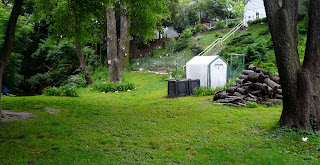Tuesday, June 18, 2013
"Don’t skinny dip with snapping turtles."
We only see these guys out of the water in early spring. We have always assumed the the bigger one is the male. The rest of the summer we may catch them laying at the bottom of the creek, stretching their heads to the surface for an occasional breath.
Snappers mate between April and November, and lay there eggs in June and July. The female can hold onto sperm for several seasons, using it as necessary. She will travel quite a distance from the water to find a sandy place to lay her eggs. She lays between 25-80 eggs, using her back legs to guide them into a pre- made hole. The eggs are covered with dirt and left to incubate for 9-18 weeks, dependent on temperature.
Snappers eat both plant and animal, making them omnivores. They ambush their pray, going after anything that they can swallow. (We once witnessed the larger snapper attempt to pull a nearly full grown duckling under the water.)
Snappers are to large to retract under their shells. When threatened, snappers make a hissing noise, and when stressed, release a musky odor from their back legs. They have powerful beak like jaws, sharp nails, and a snake-like neck that can stretch across either side of their shell to their hind feet. They can be fierce and belligerent, but given a choice, would rather flee then face a confrontation.
They have a lifespan of about 30 years in the wild.
 |
| Basking in the sun on a spring morning |
 |
| Digging a hole to lay her eggs |
Tuesday, June 11, 2013
OCCUPIED
The male Wren arrives in early spring and establishes a territory of about 1/2-3/4 acres. He keeps watch over this area from three advantage points, while singing from dusk to dawn. His singing is loud and diverse (and I find lovely!).
I watched as the male Wren busily filled several birdhouses in our backyard with twigs. Once finished, he presented the different nest to his mate. She selected this particular birdhouse and began adding additional twigs, along with grass and pine needles. Breeding season begins in March and runs through July. This is the second nesting. (The first brood was raised in the birdhouse outside our front door.)
Come Autumn, Wrens head south for the winter.
I watched as the male Wren busily filled several birdhouses in our backyard with twigs. Once finished, he presented the different nest to his mate. She selected this particular birdhouse and began adding additional twigs, along with grass and pine needles. Breeding season begins in March and runs through July. This is the second nesting. (The first brood was raised in the birdhouse outside our front door.)
Come Autumn, Wrens head south for the winter.
Monday, June 3, 2013
Subscribe to:
Posts (Atom)























